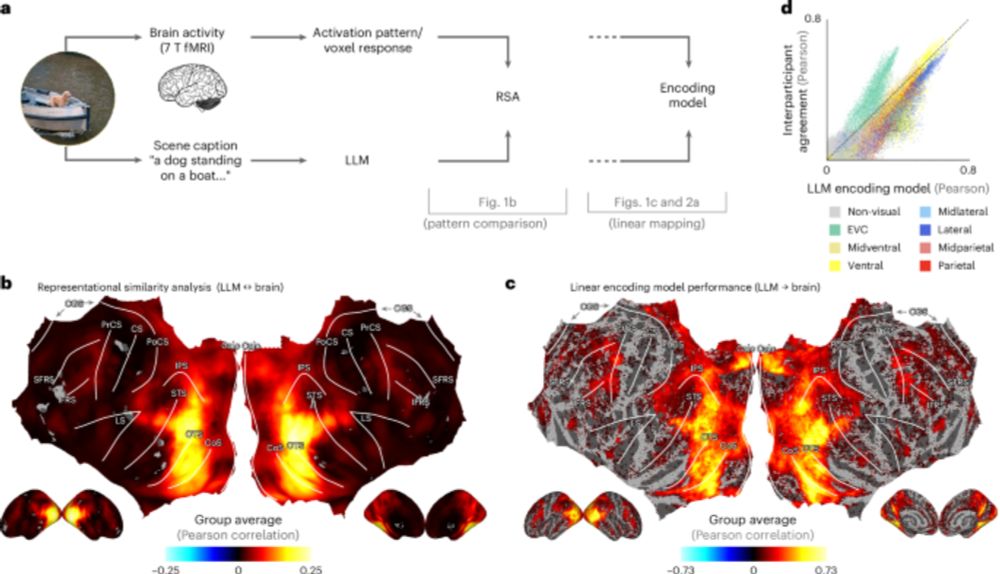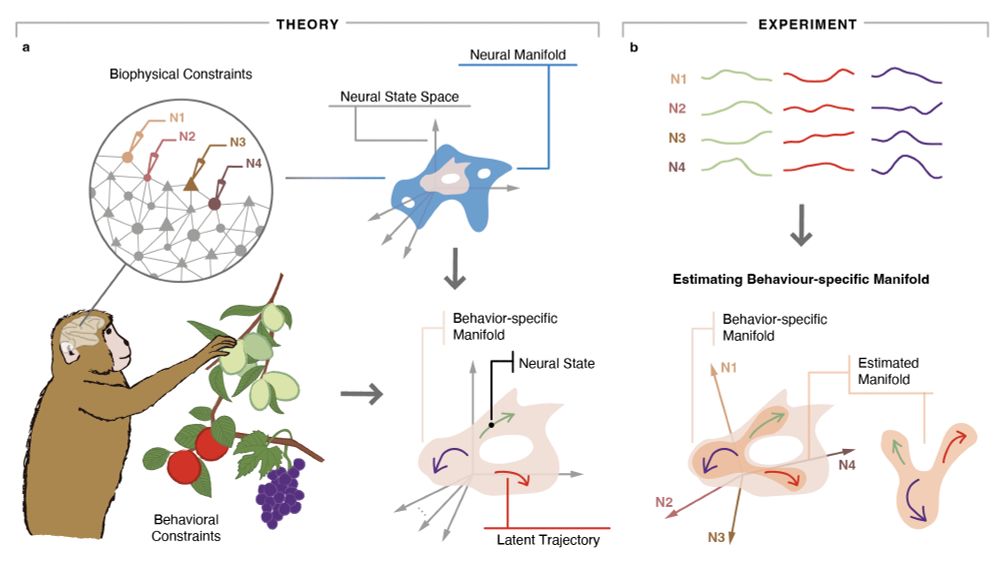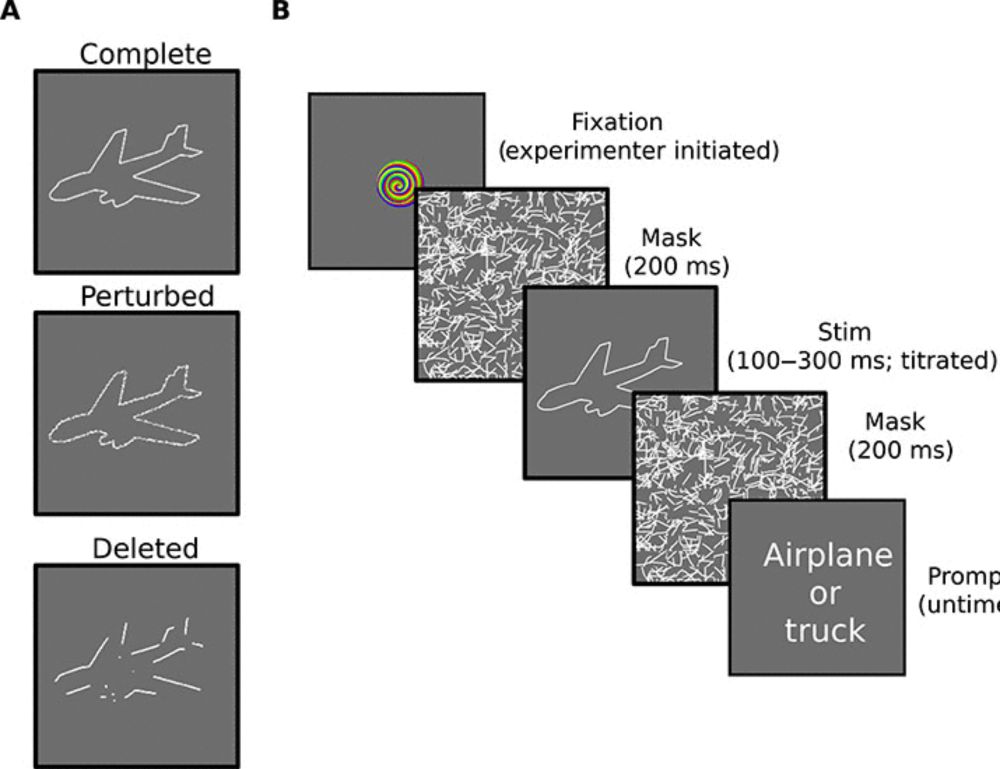
Victoria Bosch
@initself.bsky.social
neuromantic - ML and cognitive computational neuroscience - PhD student at Kietzmann Lab, Osnabrück University.
⛓️ https://init-self.com
⛓️ https://init-self.com
Reposted by Victoria Bosch
New preprint led by @pablooyarzo.bsky.social together with @kohitij.bsky.social, Diego Vidaurre & Radek Cichy.
Using EEG + fMRI, we show that when humans recognize images that feedforward CNNs fail on, the brain recruits cortex-wide recurrent resources.
www.biorxiv.org/content/10.1... (1/n)
Using EEG + fMRI, we show that when humans recognize images that feedforward CNNs fail on, the brain recruits cortex-wide recurrent resources.
www.biorxiv.org/content/10.1... (1/n)
www.biorxiv.org
November 7, 2025 at 9:39 AM
New preprint led by @pablooyarzo.bsky.social together with @kohitij.bsky.social, Diego Vidaurre & Radek Cichy.
Using EEG + fMRI, we show that when humans recognize images that feedforward CNNs fail on, the brain recruits cortex-wide recurrent resources.
www.biorxiv.org/content/10.1... (1/n)
Using EEG + fMRI, we show that when humans recognize images that feedforward CNNs fail on, the brain recruits cortex-wide recurrent resources.
www.biorxiv.org/content/10.1... (1/n)
Introducing CorText: a framework that fuses brain data directly into a large language model, allowing for interactive neural readout using natural language.
tl;dr: you can now chat with a brain scan 🧠💬
1/n
tl;dr: you can now chat with a brain scan 🧠💬
1/n

November 3, 2025 at 3:17 PM
Introducing CorText: a framework that fuses brain data directly into a large language model, allowing for interactive neural readout using natural language.
tl;dr: you can now chat with a brain scan 🧠💬
1/n
tl;dr: you can now chat with a brain scan 🧠💬
1/n
Reposted by Victoria Bosch
Figuring out how the brain uses information from visual neurons may require new tools, writes @neurograce.bsky.social. Hear from 10 experts in the field.
#neuroskyence
www.thetransmitter.org/the-big-pict...
#neuroskyence
www.thetransmitter.org/the-big-pict...

Connecting neural activity, perception in the visual system
Figuring out how the brain uses information from visual neurons may require new tools. I asked nine experts to weigh in.
www.thetransmitter.org
October 13, 2025 at 1:23 PM
Figuring out how the brain uses information from visual neurons may require new tools, writes @neurograce.bsky.social. Hear from 10 experts in the field.
#neuroskyence
www.thetransmitter.org/the-big-pict...
#neuroskyence
www.thetransmitter.org/the-big-pict...
Wow, peak library experience at Princeton!
Looking forward to a week of the “Automated Scientific Discovery of Mind and Brain” workshop - where I will also present my work on CorText and brain-language fusion 🧠
Looking forward to a week of the “Automated Scientific Discovery of Mind and Brain” workshop - where I will also present my work on CorText and brain-language fusion 🧠


September 29, 2025 at 4:40 PM
Wow, peak library experience at Princeton!
Looking forward to a week of the “Automated Scientific Discovery of Mind and Brain” workshop - where I will also present my work on CorText and brain-language fusion 🧠
Looking forward to a week of the “Automated Scientific Discovery of Mind and Brain” workshop - where I will also present my work on CorText and brain-language fusion 🧠
Reposted by Victoria Bosch
As it's hiring season again I'm resharing the NeuroJobs feed. Add #NeuroJobs to your post if you're recruiting or looking for an RA, PhD, Postdoc, or faculty position in Neuro or an adjacent field.
bsky.app/profile/did:...
bsky.app/profile/did:...
September 3, 2025 at 3:25 PM
As it's hiring season again I'm resharing the NeuroJobs feed. Add #NeuroJobs to your post if you're recruiting or looking for an RA, PhD, Postdoc, or faculty position in Neuro or an adjacent field.
bsky.app/profile/did:...
bsky.app/profile/did:...
Reposted by Victoria Bosch
🔍 Large language models, similar to those behind ChatGPT, can predict how the human brain responds to visual stimuli
New study by @adriendoerig.bsky.social @freieuniversitaet.bsky.social with colleagues from Osnabrück, Minnesota and @umontreal-en.bsky.social
Read the whole story 👉 bit.ly/3JXlYmO
New study by @adriendoerig.bsky.social @freieuniversitaet.bsky.social with colleagues from Osnabrück, Minnesota and @umontreal-en.bsky.social
Read the whole story 👉 bit.ly/3JXlYmO

September 2, 2025 at 7:01 AM
🔍 Large language models, similar to those behind ChatGPT, can predict how the human brain responds to visual stimuli
New study by @adriendoerig.bsky.social @freieuniversitaet.bsky.social with colleagues from Osnabrück, Minnesota and @umontreal-en.bsky.social
Read the whole story 👉 bit.ly/3JXlYmO
New study by @adriendoerig.bsky.social @freieuniversitaet.bsky.social with colleagues from Osnabrück, Minnesota and @umontreal-en.bsky.social
Read the whole story 👉 bit.ly/3JXlYmO
Reposted by Victoria Bosch
Our target discussion article out in Cognitive Neuroscience! It will be followed by peer commentary and our responses. If you would like to write a commentary, please reach out to the journal! 1/18 www.tandfonline.com/doi/full/10.... @cibaker.bsky.social @susanwardle.bsky.social

August 29, 2025 at 6:43 PM
Our target discussion article out in Cognitive Neuroscience! It will be followed by peer commentary and our responses. If you would like to write a commentary, please reach out to the journal! 1/18 www.tandfonline.com/doi/full/10.... @cibaker.bsky.social @susanwardle.bsky.social
Reposted by Victoria Bosch
incredible Ada Lovelace quote highlighted in a talk by Steve Furber. She spells out the dream of computational neuroscience, 2 centuries ago. The sheer ambition 🤩

August 29, 2025 at 9:21 AM
incredible Ada Lovelace quote highlighted in a talk by Steve Furber. She spells out the dream of computational neuroscience, 2 centuries ago. The sheer ambition 🤩
Reposted by Victoria Bosch
In other news, I am now a ✨ COXI ✨ (cognitive scientist in Osnabrück, Germany)
www.uni-osnabrueck.de/en/campus-li...
I'll be looking for PhD students & postdocs later this year, so watch this space if combining cognitive modelling, EEG & tFUS to study flexible cognition sounds exciting to you 🚀
www.uni-osnabrueck.de/en/campus-li...
I'll be looking for PhD students & postdocs later this year, so watch this space if combining cognitive modelling, EEG & tFUS to study flexible cognition sounds exciting to you 🚀

New at the university: Prof. Weber!
Osnabrück University welcomes Prof. Dr. Lilian Weber! Since August 15, she has held the professorship "Cognitive Modeling" at the School of Human Sciences. A warm welcome!
www.uni-osnabrueck.de
August 26, 2025 at 12:07 PM
In other news, I am now a ✨ COXI ✨ (cognitive scientist in Osnabrück, Germany)
www.uni-osnabrueck.de/en/campus-li...
I'll be looking for PhD students & postdocs later this year, so watch this space if combining cognitive modelling, EEG & tFUS to study flexible cognition sounds exciting to you 🚀
www.uni-osnabrueck.de/en/campus-li...
I'll be looking for PhD students & postdocs later this year, so watch this space if combining cognitive modelling, EEG & tFUS to study flexible cognition sounds exciting to you 🚀
Reposted by Victoria Bosch
Datasets like NSD & THINGS offer rich stimuli but often test a single task.
After great conversations at #CCN2025 on multi-task studies & generalization in brains & models, I thought I would repost our perspective for those interested in this topic. We need multiple tasks!👉 doi.org/10.1038/s415...
After great conversations at #CCN2025 on multi-task studies & generalization in brains & models, I thought I would repost our perspective for those interested in this topic. We need multiple tasks!👉 doi.org/10.1038/s415...

Centering cognitive neuroscience on task demands and generalization - Nature Neuroscience
Task demands are a primary determiner of behavior and neurophysiology. Here the authors discuss how understanding their influence through multitask studies and tests of generalization is the key to ar...
doi.org
August 18, 2025 at 7:49 AM
Datasets like NSD & THINGS offer rich stimuli but often test a single task.
After great conversations at #CCN2025 on multi-task studies & generalization in brains & models, I thought I would repost our perspective for those interested in this topic. We need multiple tasks!👉 doi.org/10.1038/s415...
After great conversations at #CCN2025 on multi-task studies & generalization in brains & models, I thought I would repost our perspective for those interested in this topic. We need multiple tasks!👉 doi.org/10.1038/s415...
Reposted by Victoria Bosch
That's a wrap for CCN2025 -- and so planning for CCN2026 in New York is starting today! Save travels to all participants and remember to fill out the feedback survey sent via email!

August 15, 2025 at 4:29 PM
That's a wrap for CCN2025 -- and so planning for CCN2026 in New York is starting today! Save travels to all participants and remember to fill out the feedback survey sent via email!
Looking for principles of neural organisation: should we ask what for or how come?
Great kickoff discussions at the “Modeling the Physical Brain” CCN satellite event! #CCN2025 #topography
Great kickoff discussions at the “Modeling the Physical Brain” CCN satellite event! #CCN2025 #topography
August 11, 2025 at 11:35 AM
Looking for principles of neural organisation: should we ask what for or how come?
Great kickoff discussions at the “Modeling the Physical Brain” CCN satellite event! #CCN2025 #topography
Great kickoff discussions at the “Modeling the Physical Brain” CCN satellite event! #CCN2025 #topography
Reposted by Victoria Bosch
🚨 Finally out in Nature Machine Intelligence!!
"Visual representations in the human brain are aligned with large language models"
🔗 www.nature.com/articles/s42...
"Visual representations in the human brain are aligned with large language models"
🔗 www.nature.com/articles/s42...

High-level visual representations in the human brain are aligned with large language models - Nature Machine Intelligence
Doerig, Kietzmann and colleagues show that the brain’s response to visual scenes can be modelled using language-based AI representations. By linking brain activity to caption-based embeddings from lar...
www.nature.com
August 7, 2025 at 1:06 PM
🚨 Finally out in Nature Machine Intelligence!!
"Visual representations in the human brain are aligned with large language models"
🔗 www.nature.com/articles/s42...
"Visual representations in the human brain are aligned with large language models"
🔗 www.nature.com/articles/s42...
Reposted by Victoria Bosch
🚨New paper🚨
Neural manifolds went from a niche-y word to an ubiquitous term in systems neuro thanks to many interesting findings across fields. But like with any emerging term, people use it very differently.
Here, we clarify our take on the term, and review key findings & challenges rdcu.be/ex8hW
Neural manifolds went from a niche-y word to an ubiquitous term in systems neuro thanks to many interesting findings across fields. But like with any emerging term, people use it very differently.
Here, we clarify our take on the term, and review key findings & challenges rdcu.be/ex8hW

August 1, 2025 at 9:57 AM
🚨New paper🚨
Neural manifolds went from a niche-y word to an ubiquitous term in systems neuro thanks to many interesting findings across fields. But like with any emerging term, people use it very differently.
Here, we clarify our take on the term, and review key findings & challenges rdcu.be/ex8hW
Neural manifolds went from a niche-y word to an ubiquitous term in systems neuro thanks to many interesting findings across fields. But like with any emerging term, people use it very differently.
Here, we clarify our take on the term, and review key findings & challenges rdcu.be/ex8hW
Reposted by Victoria Bosch
The final destination is an ontology not of a singular Universe, but of a pluriverse of viable, interacting maps. Reality, as we can know it, is not the silent, underlying territory. It is the noisy, dynamic, and ever-changing ecosystem composed of all these living, competing, and co-evolving maps.
July 31, 2025 at 2:15 PM
The final destination is an ontology not of a singular Universe, but of a pluriverse of viable, interacting maps. Reality, as we can know it, is not the silent, underlying territory. It is the noisy, dynamic, and ever-changing ecosystem composed of all these living, competing, and co-evolving maps.
The perspective that representational Universality and the ‘platonic representation hypothesis’ etc. are not addressing - multimodal / ANN-human alignment happens due to overlapping “Umwelts”, not due to all systems ultimately representing Reality™
(hot take?)
(hot take?)
Korzybski's maxim, 'the map is not the territory' is conventionally thought of as an epistemological warning about confusing symbols with reality. But what if the organism is always already a map? This transforms the maxim into a fundamental statement of ontology. 🧵 1/7
July 31, 2025 at 9:20 PM
The perspective that representational Universality and the ‘platonic representation hypothesis’ etc. are not addressing - multimodal / ANN-human alignment happens due to overlapping “Umwelts”, not due to all systems ultimately representing Reality™
(hot take?)
(hot take?)
Reposted by Victoria Bosch
What makes visual processing in the brain so powerful and flexible? Very excited to share our new work where we started from SOTA models that accurately predict dynamic brain activity during hours of video watching, and investigated core computations underlying visual perception

July 30, 2025 at 3:42 PM
What makes visual processing in the brain so powerful and flexible? Very excited to share our new work where we started from SOTA models that accurately predict dynamic brain activity during hours of video watching, and investigated core computations underlying visual perception
Reposted by Victoria Bosch
Thank you everyone for your suggestions! This turned out to be a very useful resource.
For those interested, you can see a compiled version of the suggestions from this thread here: tinyurl.com/kaz445jh
(The wiki page will be updated as we find more resources.)
🧠🤖 , 🧠📈
For those interested, you can see a compiled version of the suggestions from this thread here: tinyurl.com/kaz445jh
(The wiki page will be updated as we find more resources.)
🧠🤖 , 🧠📈
For trainees entering computational neuroscience or NeuroAI from an engineering background, where do you direct them to learn some neuroscience these days? Books, courses, ...?
And no... I'm not interested in scaring them off with Kandel!
🧠🤖, 🧠📈
And no... I'm not interested in scaring them off with Kandel!
🧠🤖, 🧠📈
July 21, 2025 at 7:34 PM
Thank you everyone for your suggestions! This turned out to be a very useful resource.
For those interested, you can see a compiled version of the suggestions from this thread here: tinyurl.com/kaz445jh
(The wiki page will be updated as we find more resources.)
🧠🤖 , 🧠📈
For those interested, you can see a compiled version of the suggestions from this thread here: tinyurl.com/kaz445jh
(The wiki page will be updated as we find more resources.)
🧠🤖 , 🧠📈
Reposted by Victoria Bosch
This summer my lab's journal club somewhat unintentionally ended up reading papers on a theme of "more naturalistic computational neuroscience". I figured I'd share the list of papers here 🧵:
July 23, 2025 at 2:59 PM
This summer my lab's journal club somewhat unintentionally ended up reading papers on a theme of "more naturalistic computational neuroscience". I figured I'd share the list of papers here 🧵:
Reposted by Victoria Bosch
My paper with @stellalourenco.bsky.social is now out in Science Advances!
We found that children have robust object recognition abilities that surpass many ANNs. Models only outperformed kids when their training far exceeded what a child could experience in their lifetime
doi.org/10.1126/scia...
We found that children have robust object recognition abilities that surpass many ANNs. Models only outperformed kids when their training far exceeded what a child could experience in their lifetime
doi.org/10.1126/scia...

Fast and robust visual object recognition in young children
The visual recognition abilities of preschool children rival those of state-of-the-art artificial intelligence models.
doi.org
July 2, 2025 at 7:38 PM
My paper with @stellalourenco.bsky.social is now out in Science Advances!
We found that children have robust object recognition abilities that surpass many ANNs. Models only outperformed kids when their training far exceeded what a child could experience in their lifetime
doi.org/10.1126/scia...
We found that children have robust object recognition abilities that surpass many ANNs. Models only outperformed kids when their training far exceeded what a child could experience in their lifetime
doi.org/10.1126/scia...
Reposted by Victoria Bosch
Exciting new preprint from the lab: “Adopting a human developmental visual diet yields robust, shape-based AI vision”. A most wonderful case where brain inspiration massively improved AI solutions.
Work with @zejinlu.bsky.social @sushrutthorat.bsky.social and Radek Cichy
arxiv.org/abs/2507.03168
Work with @zejinlu.bsky.social @sushrutthorat.bsky.social and Radek Cichy
arxiv.org/abs/2507.03168
arxiv.org
July 8, 2025 at 1:04 PM
Exciting new preprint from the lab: “Adopting a human developmental visual diet yields robust, shape-based AI vision”. A most wonderful case where brain inspiration massively improved AI solutions.
Work with @zejinlu.bsky.social @sushrutthorat.bsky.social and Radek Cichy
arxiv.org/abs/2507.03168
Work with @zejinlu.bsky.social @sushrutthorat.bsky.social and Radek Cichy
arxiv.org/abs/2507.03168
Reposted by Victoria Bosch
How is high-level visual cortex organized?
In a new preprint with @martinhebart.bsky.social & @kathadobs.bsky.social, we show that category-selective areas encode a rich, multidimensional feature space 🌈
www.biorxiv.org/content/10.1...
#neuroskyence
🧵 1/n
In a new preprint with @martinhebart.bsky.social & @kathadobs.bsky.social, we show that category-selective areas encode a rich, multidimensional feature space 🌈
www.biorxiv.org/content/10.1...
#neuroskyence
🧵 1/n
www.biorxiv.org
June 18, 2025 at 12:28 PM
How is high-level visual cortex organized?
In a new preprint with @martinhebart.bsky.social & @kathadobs.bsky.social, we show that category-selective areas encode a rich, multidimensional feature space 🌈
www.biorxiv.org/content/10.1...
#neuroskyence
🧵 1/n
In a new preprint with @martinhebart.bsky.social & @kathadobs.bsky.social, we show that category-selective areas encode a rich, multidimensional feature space 🌈
www.biorxiv.org/content/10.1...
#neuroskyence
🧵 1/n
Reposted by Victoria Bosch
What shapes the topography of high-level visual cortex?
Excited to share a new pre-print addressing this question with connectivity-constrained interactive topographic networks, titled "Retinotopic scaffolding of high-level vision", w/ Marlene Behrmann & David Plaut.
🧵 ↓ 1/n
Excited to share a new pre-print addressing this question with connectivity-constrained interactive topographic networks, titled "Retinotopic scaffolding of high-level vision", w/ Marlene Behrmann & David Plaut.
🧵 ↓ 1/n

June 16, 2025 at 3:11 PM
What shapes the topography of high-level visual cortex?
Excited to share a new pre-print addressing this question with connectivity-constrained interactive topographic networks, titled "Retinotopic scaffolding of high-level vision", w/ Marlene Behrmann & David Plaut.
🧵 ↓ 1/n
Excited to share a new pre-print addressing this question with connectivity-constrained interactive topographic networks, titled "Retinotopic scaffolding of high-level vision", w/ Marlene Behrmann & David Plaut.
🧵 ↓ 1/n


